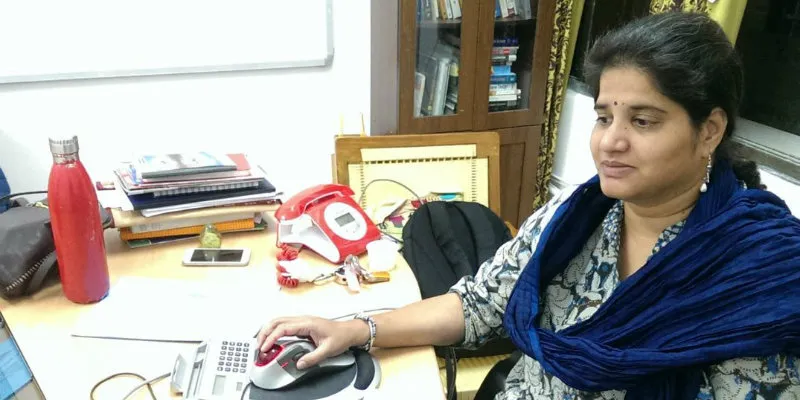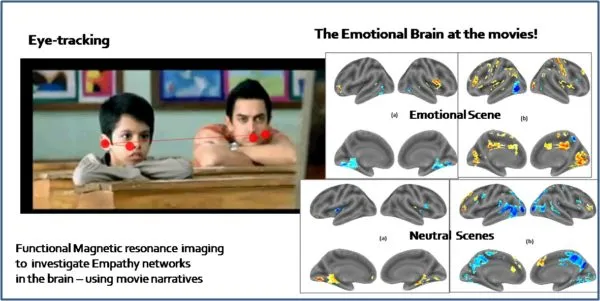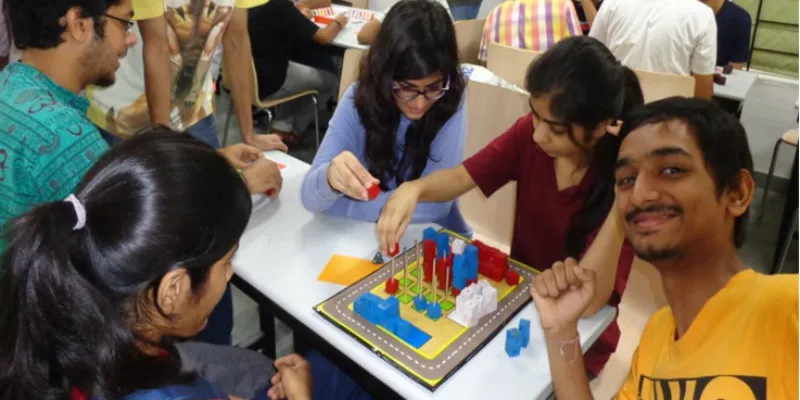[Women in Science] What’s your empathy quotient? Researcher Kavita Vemuri finds out
Using fMRI technology, Kavita detects the areas of the brain that get activated when we are feeling empathetic.
You have probably heard of Alan Kurdi. In fact, we are likely to be more familiar with this three-year-old Syrian boy than we are about the political crises (the Syrian civil war and the European refugee crisis) that killed him. The photograph of Alan’s lifeless body washed up ashore the Mediterranean Sea on September 2, 2015, affected the world in many ways. It reportedly led to a spike in the number of donations to charities helping refugees, and world leaders mourned the tragedy with not just words but even policy changes. “It was not just Syrians who felt bad. It was the entire world,” said Kavita Vemuri, a researcher at International Institute of Information Technology (IIIT), Hyderabad, who studies the science of the emotion called empathy.

“All we had in common with Alan was the human species – race, ethnicity, even the bigger political problems facing the world were forgotten. What took over was this fundamental response called empathy.” Kavita is a former electrical engineer who now studies cognitive neuroscience. A major area she focuses on is empathy. “Empathy is not a singular response – it requires a lot of cognitive processing,” she said. “For me to understand what others are feeling, I have to put myself in their shoes and look at the world how they do – ‘mentalising’ as it’s called.”
Using functional magnetic resonance imaging (fMRI) technology, Kavita detects the areas of the brain that get activated when we are feeling empathetic. Her subjects are her research students who presumably have no complaints since fMRI is non-invasive and, moreover, the experiments involve watching movies.
Three movies, three responses
“I use movies to understand these large networks because they provide very immersive narratives. Meaning, when we put healthy people in fMRI and play a movie for them, they get engaged; they don’t feel as if they are inside a machine.” This matters, Kavita says, because it requires a level of engagement for a subject to open up completely. “They are grasping the story, taking the side of one of the actors or the entire narrative. And this is exactly what we do in every social interaction,” she said.
For one of her studies, Kavita played for her 15 fMRI subjects carefully chosen scenes from three movies – the Disney movie Up, Aamir Khan’s Taare Zameen Par, and a Hollywood crime drama The Green Mile. She collected the data and compared different kinds of empathetic responses triggered in each subject during each movie. Kavita distinguished two of the types of empathy for me. “Emotional empathy is when I feel what you are feeling, whereas cognitive empathy is when I understand what you are feeling but I’m not experiencing the same.” While the limbic lobe in the central part of the brain is activated during the former, the frontal lobe is activated for the latter, she added.

The results were quite telling. While watching Up, subjects showed cognitive empathy but much less emotional empathy. Taare Zameen Par, on the other hand, triggered a high level of both types of empathy. Kavita was not very surprised by this. “In Up, though the narrative (of Carl and Ellie being told that they cannot have children) was very real, the characters were computer-generated.” So it’s possible that people relate more to live-action scenarios than animated ones.
But Kavita was most surprised by the effect of the third movie Green Mile. She described the narrative: “The main actor is an African-American. The other actors are all Caucasian. The man is on death row for a crime he has not committed, but this was not shown in the clip the subjects watched. The scene showed the jailers feeling very bad about the execution. It ends with the scene of the electric chair.”
The brain images lit up in a way that showed that all the subjects experienced very high levels of all the types of empathy studied. “There is a thing that we are all racist – he is African, not my people – but I think that at the fundamental level, we do empathise. What we need is a strong narrative and an atmosphere where we are not being controlled about what to think. Movies give us one such space – we are not controlled; we just sit there and get taken over by the narrative and cinematography.”
There was one more thing. “Many times, when I ask boys if they felt emotional about a scene, they say no. But the fMRIs show that their brains say differently. So far, we actually haven’t found any difference in empathy response between males and females,” stated Kavita. This goes against the popular opinion that females are more emotional. Kavita guesses that it is the cultural schooling most boys receive that lead them to deny this.
The ultimate goal
Testing healthy people (those considered ‘normal’) is only the first step for Kavita’s investigation into empathy. “After identifying the brain networks involved in empathy using normal healthy people, I can then study people with different types of conditions – like a social psychopath or rape-accused.” If such persons show a different response to the same triggers, it could have interesting implications. “This does not mean that the person should be excused because he/she is mentally unstable; the argument is that this particular functionality (empathy) has never been evoked in him/her,” she clarified.
What Kavita takes away from this hypothesis is that the empathy response must be triggered in an individual early in life. “For many children, I think if you trigger it early, if you tell them these are all our people and put things in a narrative, these circuits in their brains will all turn on. The fact that we don’t do it is what leads to all these problems.”
Kavita is hoping to obtain the funds to conduct this next step in her research. “Finding out if there are functionality differences in people with different conditions is a small contribution towards understanding big social problems. That’s the end goal of these studies.”
Many times, when I ask boys if they felt emotional about a scene, they say no. But the fMRIs show that their brains say differently. So far, we actually haven’t found any difference in empathy response between males and females.
When I prodded Kavita to think back to what led to her fascination with the brain, she sighed. “That’s a long way back…” Kavita grew up in Bengaluru surrounded by liberal and academic minds. Her family and friends consisted of several professors, a haven for a curious and questioning child like her.
“I had hundred-and-one questions about everything. So much that they called me ‘question’,” she recalled, describing how she once put a coin on Yeshwantpur railway track to see what would happen. Don’t worry – it doesn’t derail. “I grew up thinking this was normal, but now I realise that not everyone had big professors around who never undermined curiosity and always explained things.”
From physics to engineering
Though she was a student of physics for many years, Kavita dropped the subject mid-PhD at University at Albany-SUNY, in the US. “Physics gave me an understanding of how systems work and also made me humble because I know that we can only know a small part of the whole story,” she said. However, her PhD was in quantum mechanics, and Kavita did not enjoy theoretical physics as much as experimental. So she shifted schools and began a master’s course in electrical engineering.
After that, she worked in the R&D section of a company where she built signal correctors for long submarine cables.
She was happy working in the industry, but when her mother-in-law had a sudden stroke, Kavita and her husband decided to move back to India. The attack was sudden and Kavita was shocked about how a dynamic woman in her sixties could be totally incapacitated overnight. She found herself slowly getting immersed into the world of brain networks.
Meanwhile, she was having a tough time getting a job in fibre optics. As a result, she took up whatever came her way. Among the projects was one where she was tasked with setting up a whole centre to help small-scale industries in their technology-needs assessment. “There I worked in everything from automobile to food processing to textile industries. It gave me a lot of insight into how industry works,” she said. After this, she and her young child joined her husband in Hyderabad where he had begun a new job. Kavita applied to IIIT and successfully started their incubation centre. By the end of four years, she had helped students set up 40 companies.
The ‘Serious Gaming’ lab
This seemed like the perfect time for Kavita to finally pursue her interest in the brain sciences and somehow use her skills to advance the field. She joined the cognitive science lab and completed her PhD. Kavita’s own lab is intriguingly named ‘Serious Gaming’. She jokes that this is a ploy to get students, but in fact, it is her second major area of focus. Kavita’s Serious Gaming lab looks at more practical solutions such as neurorehabilitation. Just like she uses movies as a medium to study networks in the brain, here she and her students develop games to enhance the working of the networks. “When you have a stroke, an accident or any motor-movement injury, recovery takes a long time and is very expensive. Rehab centres work with patients for six months or more, and their exercises usually work but are very routine and boring. My question is – we have the technology, so why are we still doing those old exercises?”
For Kavita, the answer was simple – games. “We have built a whole integrated system of hardware and software. Patients play the game but controls are through the exercises they need to do. For example, if a patient has to walk, he/she walks on a sensory mat.”
They even added motion sensors that can detect if the person is moving too slow or has not moved for a long time and introduces situations that prompt them to correct their actions accordingly. All of the games that emerge from her lab are designed and tested based on the advice of the doctor at a collaborating clinic.
Making the most of the phantom limb
One game is based on V.S. Ramachandran’s mirror box therapy. While Ramachandran used the mirror to cure the imaginary pain suffered by amputees in their amputated limb, Kavita’s games use mirrors to play perception tricks on patients to regain movement in their paralysed limb. “We give this optical illusion that the patient is actually using his/her paralysed hand. In one experiment, my students put something gooey in a box. The patient put his good hand into the box but in the mirror, it looks to him like it’s his opposite hand in the box. When the good hand touched the gooey item, we noticed that he actually impulsively pull the paralysed hand back!”
Even such a small movement is significant progress in neurorehabilitation. Sensors in the game can record such nerve impulses, and doctors are able to see that the nerve is functional. Our brain is said to be plastic, reminds Kavita. So if one part is gone, another takes over. This is the principle that makes neurorehab work. Research like this can reveal which part of the brain takes over and why it takes over faster for some than for others.
Personalising games for patients
While the team was in the thick of this game development, Kavita always kept an eye out to make sure they were on the right track. When she noticed that women were not doing as well in the games as men, she knew something was up. She talked to one of the female patients, an old lady who suffered from paralysis. “She told me that all the games had men avatars running or playing catch, but in real life, she had never done those things.”
Mulling over this hitch, Kavita recalled that this same lady had once expressed her desire to go to the pilgrimage site of Tirupati when she became well again. “So I came back [to the lab] and said OK, I will give her Tirupati!” The team built a system where the exercise machine has pedals that will enable the player to climb the stairs of a virtual Tirupati. “My students even included music and the mini-temples on the side. The energy level reflects the pulse of the player so if needed, the game asks them to stop.”
The Tirupati game was a hit among the patients at the clinic. This reemphasised for Kavita the need to create games that people can relate to. “Those of us who don’t believe in god may not realise it, but for many, the power of belief is all they have to hope that tomorrow will be a better day. This game was built for these people, who want to get immersed at least for those 10-15 minutes.”
Kavita’s lab has also developed serious games for urban planning as well as military and sports strategising. Some of their work can be seen on their lab website.
Kavita’s toy shop
At the end of their course, Kavita’s students all have to come up with physical prototypes of the games that they designed. This means her lab has a room full of toys and board games. These include games designed for children with different learning abilities like autistic and disabled children. Some of these games are patented, but Kavita is a strong proponent of making her technology available to all. “I’m not going to commercialise anything. We are looking for companies that can build the hardware for us. We build prototypes, we test them, but we are not industry. Everything is open-source.”

In the technology arena, Kavita has often felt that women are more likely to be unheard. Nevertheless, she finds the situation in India a lot better than in the West. “Here, after a certain level, you are not seen as your gender. Yes, there will be people who don’t listen, but at least you don’t have to do anything you don’t want to do to get your promotion. For example, if I don’t want to go for Friday Happy Hour, it’s all right.”
The problem, according to her, is a lack of support for young female researchers. “It’s not just about having a day-care centre. When a young woman researcher has to leave early to pick up her kids from the bus stop, there are comments like ‘oh, you’re so lucky you can go whenever you want.’ If it were me, I would have hit that person. Why should the woman be apologetic about this? When my husband did this for our child, nobody asked him anything. But they look at women as if they won’t be working as much. This peer-to-peer attitude can affect us most. If that changes, everything will change.”


![[Women in Science] What’s your empathy quotient? Researcher Kavita Vemuri finds out](https://images.yourstory.com/cs/wordpress/2018/01/kavita11-1.jpg?mode=crop&crop=faces&ar=2%3A1&format=auto&w=1920&q=75)




